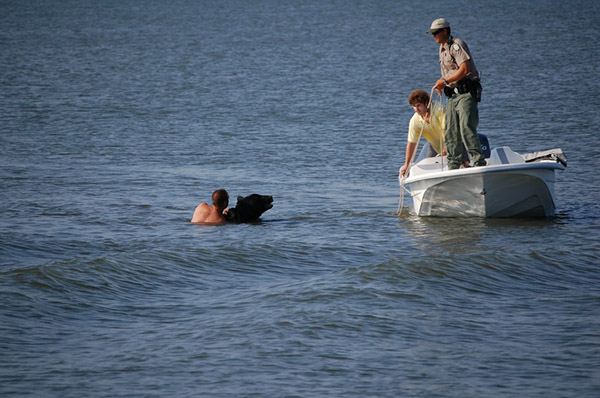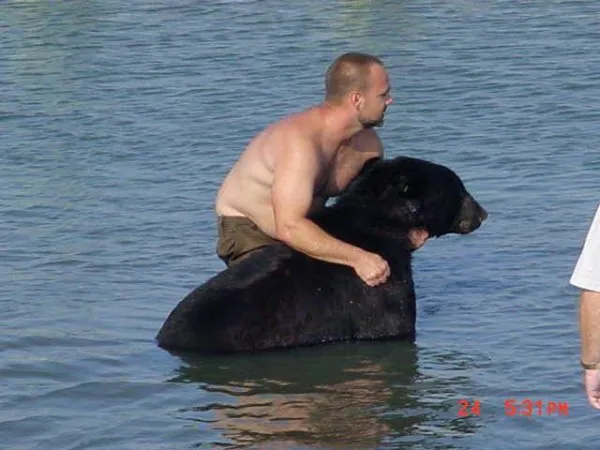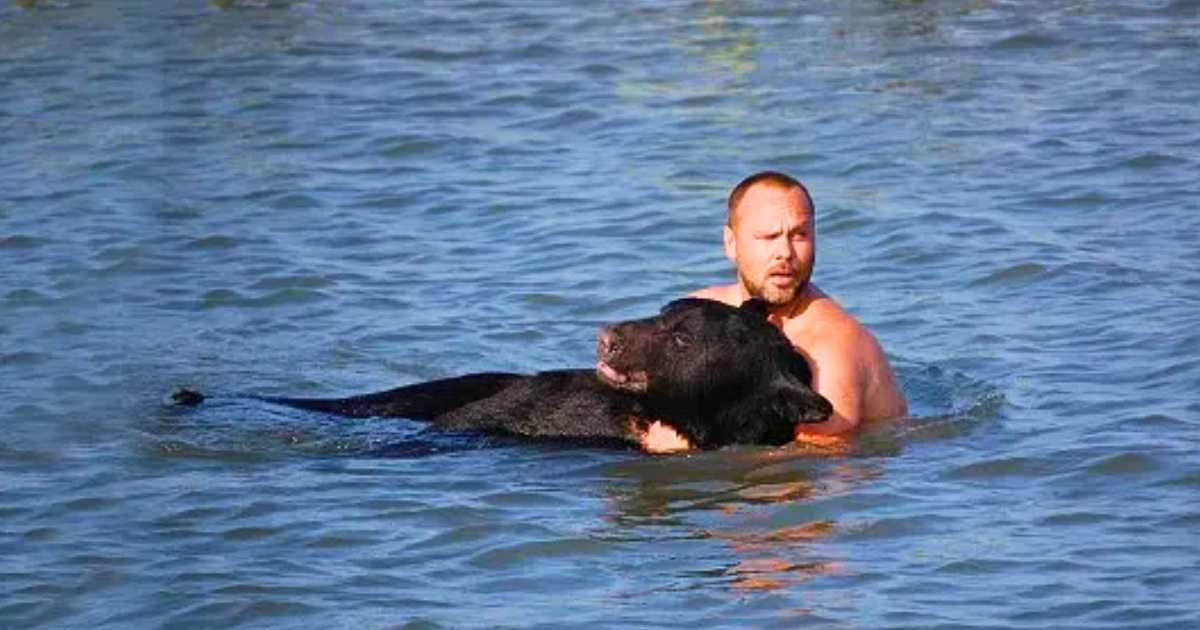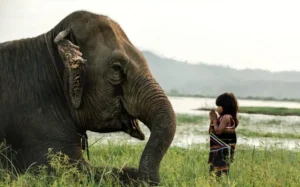In one of the most unforgettable acts of rescue in recent memory, a Florida wildlife biologist risked his life to save a massive black bear struggling to stay afloat off the coast of Alligator Point. The 375-pound bear had been wandering through a neighborhood in search of food before things took a dangerous turn. What followed was a rare display of courage, compassion, and the deep bond that can exist between humans and wildlife.
A Bear in Trouble
Residents of Alligator Point, Florida, were startled when they spotted a large black bear roaming their neighborhood. Hungry and disoriented, the bear had wandered far from the forest, likely drawn by the smell of garbage bins and pet food. Concerned for their safety and the bear’s, locals called the Florida Fish and Wildlife Conservation Commission (FWC) for help.
When officers arrived, they made the difficult decision to sedate the bear for relocation. A tranquilizer dart was fired, but what happened next quickly escalated into a life-or-death situation. The startled bear, confused and partially sedated, ran straight toward the ocean.

The Escape Into the Sea
Instead of slowing down, the tranquilized bear plunged into the Gulf of Mexico and began swimming—determined, but weakening fast. FWC officials watched helplessly as the animal tried to cross several miles of open water. The sedative started taking effect, and the bear’s powerful strokes turned sluggish.
Biologist Adam Warwick, who had been observing the scene, instantly understood the danger. A tranquilized animal that size wouldn’t stay afloat for long. Without hesitation, he stripped off his shirt and shoes, handed them to a colleague, and dove into the water.

A Dangerous Swim Toward a Wild Animal
Warwick swam toward the 375-pound bear, knowing that one wrong move could end badly. Black bears are strong, unpredictable animals, and even a dazed one can be lethal if frightened. Yet, what drove him wasn’t adrenaline—it was duty and compassion.
“I couldn’t just watch him drown,” Warwick said later. “He was clearly terrified and disoriented. Someone had to do something.”
The bear, now half-submerged, began to sink. Warwick reached it just in time, grabbing the animal from behind to keep its head above water. For the next several minutes, man and bear floated together—one fighting exhaustion, the other unconsciousness.

Strength and Instinct in Action
It took every ounce of strength Warwick had to guide the bear back toward the shore. The currents pushed them sideways, and the sedative continued to take hold. The sight was both tense and inspiring: a man wrestling waves and gravity to keep a wildlife giant alive.
By the time they reached shallow water, the bear was almost motionless. FWC officers rushed in to help, using a backhoe to gently lift the bear from the surf. Together, they placed it in a wildlife truck, where it was taken to a safe area deep in the forest.
Read More: Man Loses 360 Pounds Naturally — Internet Rallies to Support His Next Step
A Moment That Defined Compassion in Nature
Stories like these don’t just tug at the heart—they challenge our understanding of courage and coexistence. Warwick’s quick thinking didn’t just save one bear; it reminded us that empathy can transcend fear. In an era where human-wildlife encounters often end badly for the animals, this story stood out as a rare example of partnership with nature.
Wildlife rescues like this also serve a bigger purpose. They highlight how habitat loss and urban expansion force animals into human spaces, where danger is almost inevitable. Each rescue, whether in Florida or beyond, is a wake-up call about the fragile balance between development and conservation.
What Happened to the Bear Afterwards
After the dramatic rescue, the bear was checked by veterinarians and found to be in good health, aside from exhaustion. Once it recovered from sedation, it was released safely into the Apalachicola National Forest — far from neighborhoods and highways.
The FWC later shared photos of the bear resting peacefully on the forest floor, its eyes half-closed but alert. For Warwick and his team, the relief was immense. Their mission was a success — not just because a life was saved, but because the story sparked new conversations about humane wildlife management.
Why This Story Still Matters
Viral moments fade quickly, but the message here doesn’t. Warwick’s decision to risk his own life for a bear shows what real conservation looks like in practice. It’s not about heroics for the camera; it’s about instinct, empathy, and accountability to the natural world.
In a society that often separates humans from nature, such moments bridge the gap. They remind us that our actions—big or small—have real consequences for the creatures who share our environment. Whether through organized rescue work or simple awareness, protecting wildlife begins with recognizing its worth.
Full Story: The Hidden Meaning Behind Princess Diana’s Cannes Gown — A Heartfelt Farewell to Grace Kelly
The Ripple Effect
Since that day, Warwick’s act of bravery has been shared around the world as a symbol of hope. It continues to inspire people working in wildlife conservation — a reminder that empathy doesn’t require perfection, only courage and action.
The bear may never know who saved it, but the rescue changed more than one life that day. It proved that compassion isn’t limited to humans; it’s a force of nature itself.


